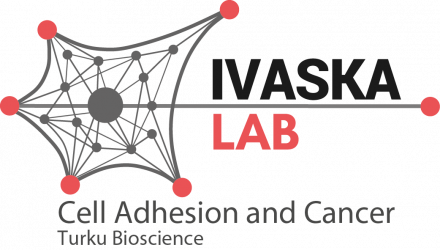Integrin β1-mediated adhesion is dispensable in early mouse embryogenesis (pre-implantation) but indispensable post-implantation, suggesting distinct roles for β1-integrin-mediated adhesions in the naive (pre-implantation) versus primed (post-implantation) pluripotent stem cells (PSCs). We investigated the role of integrin β1 in regulating naive-like…
Dynamic regulation of integrin β1 phosphorylation supports invasion of breast cancer cells by James R W Conway et al.
Integrins provide an essential bridge between cancer cells and the extracellular matrix, playing a central role in every stage of disease progression. Despite the recognized importance of integrin phosphorylation in several biological processes, the regulatory mechanisms and their relevance remained…
mTORC1 shutdown unleashes TFEB to drive triple-negative breast cancer invasion by Michalis Gounis et al.
The PI3K/AKT/mTOR pathway is considered a key therapeutic target in triple-negative breast cancer (TNBC). In this issue of Developmental Cell, Remy et al. challenge this idea by demonstrating that mTORC1 inhibition activates TFEB, promoting MT1-MMP exocytosis, ECM degradation, and increased…
Defined extracellular matrix compositions support stiffness-insensitive cell spreading and adhesion signaling by James R W Conway et al.
Integrin-dependent adhesion to the extracellular matrix (ECM) mediates mechanosensing and signaling in response to altered microenvironmental conditions. In order to provide tissue- and organ-specific cues, the ECM is composed of many different proteins that temper the mechanical properties and provide…
IGFBP2 secretion by mammary adipocytes limits breast cancer invasion by James R W Conway et al.
The progression of noninvasive ductal carcinoma in situ to invasive ductal carcinoma for patients with breast cancer results in a significantly poorer prognosis and is the precursor to metastatic disease. In this work, we have identified insulin-like growth factor-binding protein…
Myosin-X recruits lamellipodin to filopodia tips by Ana Popović et al.
Myosin-X (MYO10), a molecular motor localizing to filopodia, is thought to transport various cargo to filopodia tips, modulating filopodia function. However, only a few MYO10 cargoes have been described. Here, using GFP-Trap and BioID approaches combined with mass spectrometry, we…
PP2A methylesterase PME-1 suppresses anoikis and is associated with therapy relapse of PTEN-deficient prostate cancers by Anna Aakula et al.
While organ-confined prostate cancer (PCa) is mostly therapeutically manageable, metastatic progression of PCa remains an unmet clinical challenge. Resistance to anoikis, a form of cell death initiated by cell detachment from the surrounding extracellular matrix, is one of the cellular…
An extracellular receptor tyrosine kinase motif orchestrating intracellular STAT activation by Katri Vaparanta et al.
The ErbB4 receptor isoforms JM-a and JM-b differ within their extracellular juxtamembrane (eJM) domains. Here, ErbB4 isoforms are used as a model to address the effect of structural variation in the eJM domain of receptor tyrosine kinases (RTK) on downstream…
MYO10-filopodia support basement membranes at pre-invasive tumor boundaries by Emilia Peuhu et al.
Ductal carcinoma in situ (DCIS) is a pre-invasive stage of breast cancer. During invasion, the encapsulating DCIS basement membrane (BM) is compromised, and tumor cells invade the surrounding stroma. The mechanisms that regulate functional epithelial BMs in vivo are poorly…
